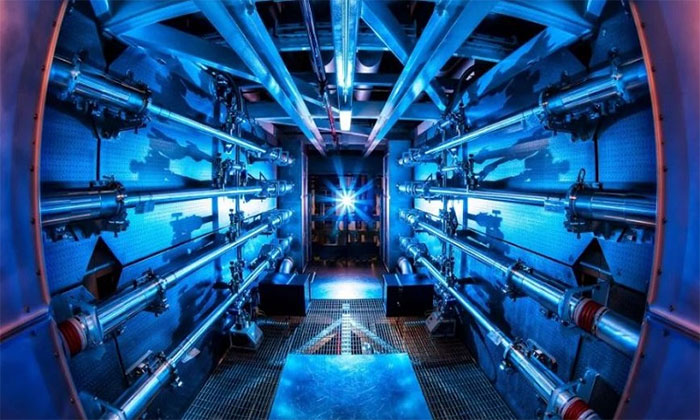Experiment to generate 10 million billion watts of electricity in a split second
Lawrence Livermore National Laboratory successfully performed a record-setting fusion experiment powered by hydrogen plasma inside the fuel chamber.
Last year, scientists at Lawrence Livermore National Laboratory in Northern California announced a record release of 1.3 megajoules of energy in 0.000000001 seconds at the National Ignition Facility (NIF). In two new studies published in Nature Physics and Nature, the team at NIF say they achieved this through the precise design of the microcavity and fuel chamber at the heart of the world's most powerful laser system. where fusion takes place.

NIF fusion takes place at the heart of the world's most powerful laser system, consuming about 400 megajoules of energy per burn.
Although the fuel chamber is only about a millimeter wide and the fusion reaction lasts only a fraction of a second, the system's capacity is equivalent to 10% of the total energy from sunlight reaching Earth. The system releases so much energy because the reaction process heats the remaining fuel into a plasma that is high enough temperature to allow more fusion reactions to take place, says Annie Kritcher, a physicist in the Chamber Lawrence Livermore National Laboratory (LLNL). Kritcher is the lead author of a study published January 26 in Nature Physics describing how NIF is optimized to generate hot plasma. He also co-authored another study published in the journal Nature on the same day, detailing the first hot plasma experiments at NIF in 2020 and early 2021.
Fusion is the process that powers stars like the Sun. This reaction is different from the fission reaction commonly used in power plants on Earth to produce energy by splitting the nucleus of a heavy atom such as plutonium into smaller atomic nuclei. Fusion reactions release huge amounts of energy when atomic nuclei combine to form larger nuclei. The simplest type of fusion reaction uses hydrogen fuel. The researchers hope that in the future, fusion could evolve into a relatively "clean" energy source using hydrogen, which is abundant in Earth's oceans.
Because stars are so massive, strong gravity means that fusion reactions take place at very high pressures. But on Earth it is not possible to create such great pressure. Instead, fusion must occur under extreme heat. Researchers have tried many different methods to maintain fusion reactions at high temperatures, and NIF focuses on an approach called "holding by inertia". This method generates high heat by firing 192 high-powered lasers at a hydrogen pellet in the center. These lasers consume huge amounts of energy and can only fire once per day.
The method of inertial holding has a long way to go before it becomes a viable energy source, as it requires evaporating several pellets of fuel per second to obtain enough energy to produce electricity. But recently NIF has proven successful in achieving super high power output in a short time. An experiment last August produced nearly as much energy from the fuel pellet as it expended. The researchers hope future experiments will be even more powerful.
Two new studies describe plasma combustion experiments conducted in the months before the reaction that generated 10 million trillion watts of electricity. Previous experiments produced 170 kilojoules of energy from a hydrogen fuel pellet weighing just 200 micrograms. The team achieved this milestone through careful shaping of the fuel chamber (a spherical polycarbonate diamond shell surrounding the fuel pellet) and chamber (small cylinder of gold-coated depleted uranium, aka hohlraum). .
The new design allows NIF's laser machines to heat the pellet for more efficient operation inside the hohlraum. As a result, the hydrogen fused at such a high temperature that other parts of the fuel pellet The guy who once set a world record for stacking three eggs on top of another broke his own
- Power plant in backpack
- Harvard announced 2.3 million new compounds that generate electricity from the sun
- The team of scientists who make 'reverse solar cells', in the dark, also generates electricity
- Build solar power plant in HCMC
- Generate electricity from garbage
- Carbon nanotube can generate large currents
- Use beer residue to generate electricity
- Turn urine into electricity
- Strange 5 animals capable of generating electricity
- Phone can take electricity from human body
- Producing electricity from death lake
- The satellites can provide electricity in the future
 Norway built the world's tallest wooden tower
Norway built the world's tallest wooden tower Kremlin
Kremlin Ashurbanipal: The oldest royal library in the world
Ashurbanipal: The oldest royal library in the world Decoding the thousand-year construction of Qin Shihuang shocked the world
Decoding the thousand-year construction of Qin Shihuang shocked the world Discover the world's first reactor that can produce endless energy
Discover the world's first reactor that can produce endless energy  Plasma fusion engine could enable intergalactic travel
Plasma fusion engine could enable intergalactic travel  New Zealand company moves closer to unlimited fusion energy
New Zealand company moves closer to unlimited fusion energy  Hundred times hotter than the core of the Sun, this country's rocket engine leaves American and Chinese rockets in the dust
Hundred times hotter than the core of the Sun, this country's rocket engine leaves American and Chinese rockets in the dust  100 MW power generation fusion reactor
100 MW power generation fusion reactor  French artificial sun sets plasma record
French artificial sun sets plasma record 